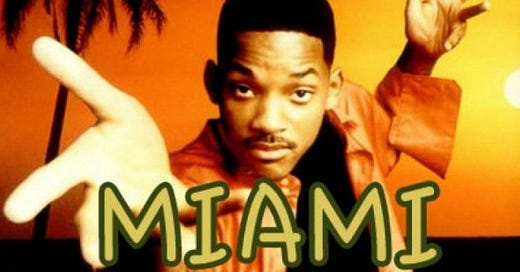Hello and welcome to the first Late of 2021.
Here’s hoping the year ahead doesn’t get upended the same way as the last.
If you’re new here, thanks for signing up. Late is free to read and plans to remain that way indefinitely.
If someone forwarded this your way or you found this post through Twitter or other channels, make sure to sign up below so you never miss an issue. We aim to publish each Sunday.
And now, Miami.
When 2020 began, remote work was a part of the conversation about the future of the enterprise.
As 2021 begins, it is the only conversation.
And amid this discussion around what a business’ real estate footprint should look like, how recruiting habits should or need to change in a newly distributed world, and where you, an upwardly mobile knowledge worker should live, all roads now lead to Miami.
Or at least, that’s today’s bit.
The whole thing, of course, is just reactionary.
I’ll admit that I’m reluctant to even approach the Miami Meme because it has so quickly devolved towards the internet’s requirement that you be either for or against some person/place/thing with no in-between. And yet about Miami itself I am neutral.
But the speed with which those who either have or are planning to move to South Florida — a journey taken by millions of retirees for generations — have declared it an imperative in understanding the future of American Capitalism is overwhelming.
Souring on the place that made you is a foundational part of western storytelling. We don’t tell tales about heroes that stayed home and enjoyed their life’s fortunate and lucky circumstances. The template is called “voyage and return” not “things are pretty good here and the weather is nice.” The San Francisco renaissance of the 2030s or ‘40s will be a sight to see.
At first glance, the Miami Meme appears to be a parody of the movement politics that define our world today. Another example of how intellectual independence has come to be defined by the number of converts one can win in the shortest amount of time. But, of course, it’s not really about Miami at all. Or at least not specifically and exclusively. Every reference to Miami in this piece can be subbed out for Austin today and somewhere else tomorrow.
And so this burgeoning movement of people and capital stands as a strange and unexpected learning to come out of a decade that saw software definitively eat the world.
Software is designed to optimize. Software’s goals are efficiently, quickly, and correctly solving problems that were previously intractable or overly cumbersome. Software is a great way to make things in the real world easier to do — drive, pay bills, find a job, meet friends. Software specializes. The software approach to problem solving is: identify, test, iterate, refine, update, repeat. It’s a digitally codified version of how humans have problem solved their way from cavemen to today’s modern version. On the one hand, software offers a novel approach. On the other hand, it’s just a digital rewrite of how we got here in the first place.
But so it is with some curiosity that we witness the pandemic’s most concrete early consequence — a rapid digitization of all commercial and professional habits and social connections — manifest as a fight over where to physically locate.
The common refrain is that you can “live anywhere” if work is increasingly digital. A claim that assumes many of those who have had their professional lives converted from interminable physical meetings to tedious Zoom calls were living somewhere they’d have rather not. And which further suggests a kind of hardcore Cartesian argument that says our physical bodies are but vessels to be located in low-tax locales with the internet rendering our minds boundless and real across digital space.
The entire meme also glosses over the actually living part of relocating to an optimized city that will reflect how deeply you understand the future. The beaches are nice in Miami, but the meme is driven by how nice the mayor has been. And the mayor of any city could’ve been just as nice. And probably will be in the years ago.
And, of course, the Miami Meme has gained so much steam because it touches the third rail of American life — real estate.
Where one lives and the value they associate with that decision is a unique global marker of being American. And so like all of the American readers out there, I’m highly conflicted and biased when it comes to my view on what matters and what doesn’t when it comes to living in a place.
This argument isn’t about trying to convince anyone that I’m right about anything. Live wherever you want. I know many readers will think I’m writing this as a bagholding sad boy because we just bought a home in a high-tax suburb of a high-tax state. Except we bought the house because that’s where we want to live.
But the Miami Meme says you can’t think this way, or at least you should try not to think this way. Because what you want isn’t necessarily optimized. There should — nay, must — be a combination of favorable tax laws and appreciative local government officials wherever it is you make your home because these are inputs you’d never ignore in building a piece of software. So why wouldn’t you run your life the same way?
Being near friends or family or just liking a place because that’s where you’ve lived for a long time is not a part of this calculus — is to be shunned in the Miami Meme world — because these factors are intangible. And software needs concrete inputs. (Unless it’s a DCF model, then you can make up whatever you want!)
As many have done during the pandemic, my wife and I talked about all the places we could or should move. She grew up in northeast Ohio and there are some great suburbs there and so I became quite familiar with the Zillow stock in the area. But I was always more into the plan and, alas, we are not moving to Ohio.
So but late last year, Curbed polled some media folks about their Zillow habits and my friend Taylor Lorenz flagged a cool A-frame in Chagrin Falls I was quite familiar with. Except this house is not in Chagrin Falls.
It’s about a 15 minute drive from the A-frame to downtown Chagrin, it’s located in a different school district, and I must know how the local real estate lobby got this address listed as Chagrin Falls instead of Bainbridge, the town in which this home is clearly located. This is the suburban version of saying an apartment on 6th Ave and 32nd St in Manhattan is located in “NoMad” (North of Madison Square Park) instead of “Literally across the street from Penn Station.”
But this too-long discussion of the northeast Ohio real estate market is just meant to point out the thing every reader here knows about living in a place — you don’t know what it’s like until you live there. And never quite as you imagined either way.
Buying a house or a condo for less than you’d pay in a different city is a tough consolation prize for finding out your new dwelling isn’t all that close to the few people you thought you’d know in the New City because Zillow didn’t exactly make clear that “no one” would ever go from this side of town to that side just to have a drink. Or that it’s not easy to actually get Ubers in that part of town. Or that the grocery store you actually want to shop at is 20 minutes away, not 6. And so on.
In May 2020, Drew Austin at Kneeling Bus wrote about our collective and rapid descent into quarantine exposing the way in which physical spaces had become purely consumptive ones.
As the American urban environment has grown [increasingly] privatized, consumption has been the primary way to engage with it. Spaces where we can do anything other than eat, drink, shop, or exercise have diminished, swallowed up by what Koolhaas calls junkspace. In other words, the outside world has assumed a lot of the same qualities as the contemporary internet over time. [...]
In New York, the parts of the city that aren’t defined by consumption are specifically what’s still open. Junkspace is closed and we can only occupy the interstitial spaces between establishments searchable on Yelp. The exterior urban environment has unintentionally decoupled from the economy, and to spend time outdoors in these conditions is to re-establish a more direct relationship to space that normally extracts value from us at every turn.
I never quite knew how I felt about this piece except that I thought it was good writing and I couldn’t get it out of my head. I’m not particularly outdoorsy nor do I feel all that connected to nature. I won’t pretend to be anything other than a late capital millennial who enjoys a walk outside as much as the next person but also let me just see how that tweet is doing.
Physical things to me and my peers are still-working gadgets about to become the next generation of electronic garbage. The “physical world” is just a collection of places to sit, stand, or move through while you consume digital content and swipe a rewards-optimized credit card. The rise of the “tactical lifestyle” is the natural outgrowth of our collective conquering of physical space: preparing for physical confrontation becomes a true hobby in a world where common spaces are zoned out of existence.
The world Austin describes is one in which places change only in the consumption opportunities they present. A depressing, if accurate, assessment. How and if this changes after COVID remains to be seen. But using the pandemic as a trigger for uprooting one’s life because they didn’t like how officials they would’ve had a future say in replacing responded to these challenges doesn’t augur well. Then again, the beach is nice.
And yet if the current discussion about the future of work has accepted a remote future as table stakes and moved on to a debate about where we ought to be plugging in our laptops from, it is odd that there are any preferences at all for where one does or does not relocate to. The more digital the real world becomes, the less it matters where anyone is physically located: you can always pretend to be somewhere.
The Miami Meme’s grand irony, then, is that it refutes the “work from anywhere” argument it purports to advance.
But it’s also clear that the Miami Meme isn’t about Miami at all. It’s a product launching in beta.
So as we transition out of a decade in which the software approach to problem solving was adopted as the default attack mode for all business problems, we’re advancing the examination of one’s personal life along these same lines. This trend started with biohacking and continues with Miami.
I eagerly await future updates.




